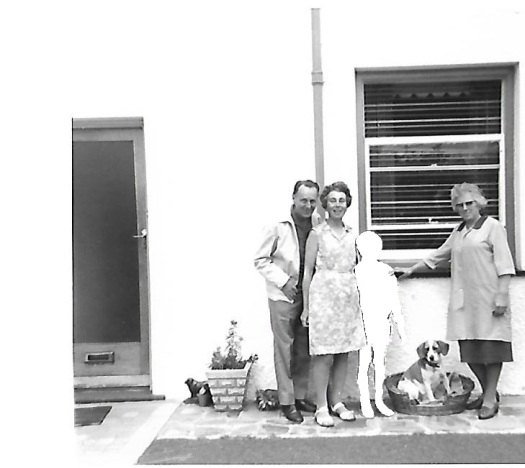
Any book which begins with a mini deconstruction – and a superb one at that – of Sapphire and Steel and its ‘broken time,’ has to be doing something right.
I’m a bit of a latecomer to hauntology, which seems oddly appropriate given the genre’s focus on absence, displacement and loss. Mark Fisher’s collection of essays and k-punk blog posts, Ghosts of My Life: writings on depression, hauntology and lost futures [Zero Books, 2014], suggests hauntology as an academic turned popular perspective may have peaked around 2006 though hauntological artefacts – such as those of musical collectives Belbury Poly and The Advisory Circle – continue to manifest (of course there is no ‘School of Hauntology’ only artists sharing a similar existential orientation). Influences as diverse as retro science-fiction, Anglo-folk, avant-garde electronic, paganism, ruralism, interval music and found music somehow make complete sense when brought together under the hauntology mantle.
For the purposes of Ghosts of My Life, hauntology (the term was coined by Derrida) is essentially about grieving for modernism and the ideals which inspired it. The disbanding of the BBC Radiophonic Workshop in 1998 and the closure of the Central Office Of Information in 2011 were two key cultural touchstone moments in hauntological history.

Imagine a world where the output of the BBC Radiophonic Workshop at its most experimental came to define popular culture as much as say, The Beatles. Nobody would argue that this is the case and yet the semi-forgotten interval music, library music and public information films of the 60s and 70s – at the very margins of and cracks between what you might call the mass icons of the age – were part of the actual grain and day-to-day quotidian feel of that time as much as the cultural behemoths. Fisher makes clear his disdain for the I Love 1973 school of commodified nostalgia with its endless reappropriation as a series of ever diminishing returns.
Nostalgic for what?
Charged with allegations of nostalgia, hauntology will retort ‘nostalgic for what?’ The issue is not whether the 70s were in some way ‘better’ than the present as if we had to choose between social security and the internet. Fisher argues that what should haunt us is not the ‘no longer’ of modernist architecture, public service broadcasting or even school textbooks but the ‘not yet’ of the futures that popular modernism inspired us to anticipate but which never materialised.
The book is a trifle over-written, brilliantly so at times. It’s quite easy to forgive this because of Fisher’s passionate commitment to unearth meaning. Sometimes I find myself asking whether he is responding squarely to the source before him or to responses to his responses, as if overly embroiled in his own multilayered fascinations. I feel I can say this because I have the same tendency. Here he is describing Joy Division’s ‘She’s Lost Control’, how it ‘traverses Poe-like cataleptic black holes in subjectivity, takes flatline voyages into the land of the dead and back to confront the ‘edge of no escape’ seeing in seizures little deaths which offer terrifying but exhilarating releases from identity, more powerful than any orgasm.’ This is too passionate, too genuinely intensely felt to be pure hyperbole.

I enjoy Fisher’s plays with time – ‘Joy Division were channelling our present, their future’ – which are not merely intentionally, provocatively dizzying but seem to get to the nub of what hauntology, (or contemporary nausea, depending on your point of view) is all about.
The chapter on Tinker, Tailor, Soldier, Spy is pertinent and vital even for a reader such as me who (I say shame-facedly) has yet to see the definitive 1979 BBC series though I did catch the recently repeated Smiley’s People on BBC Four. (I would have said television actors just can’t do underplayed anymore but then along came Mark Rylance’s Thomas Cromwell in Wolf Hall, a performance almost as compellingly sparse as Alec Guinness’s).
I wonder if you have to concur with the book’s overtly political stance? Is a ‘hauntological’ perspective necessarily a leftist one? The political angle seems integral yet surely a neoliberal can feel the same sense of loss for the cultural products of social democracy, let alone its ‘stain of place,’ as the hauntologist?
Missing the future
I’m a little disappointed that Fisher tends to dwell on the late 70s though he rightly regards this period is a crucial turning point between the breakdown of the post-way consensus and the emergence of neoliberalism. Still, as a 60sophile, I would have preferred more on specifically 60s utopianism and its resonances for us today.
The book implies that the author’s own depression was an almost unavoidable response to the dismantling of modernism. It would have been good to have heard more about the ‘depression’ aspect of the title but I appreciate that Fisher might not wish to move personal aspects centre-stage.

Although hauntological music can be intelligent and evocative, I find I like and am stimulated more by hauntological ideas rather than the music in and of itself. All music is necessarily inspired by what has gone before, yet hauntological music, for all its concern with possible futures, seems avowedly and actively to require a particular idea of the past. How long might hauntology persist? What might hauntology mean for future generations who will have no direct recall of the 60s and 70s?
There have always been lost futures but what gives these particular lost futures so powerful a resonance as to inspire an entire field of endeavour? Perhaps their potency derives from the power of recorded media to effortlessly replay aspects of our past so that we are perpetually caught in games of ‘compare and contrast’ with our own recollections and with the here and now. This shift in consciousness was impossible before a pre-photographic and, more particularly, a pre-media age. Hauntology itself would seem to be a creation of mass media.





